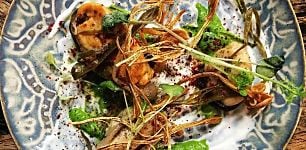Toronto-based chef Dave Mottershall, owner of Loka, the city's first Kickstarter-funded restaurant, is known for his beautiful food plating ideas. The former Prince Edward Island resident created pop-up sensation Loka Snacks in Toronto before moving into his brick-and-mortar location. He documents his journey on Instagram where 46,300 people follow his every move. We got Mottershall's insider perspective on where he gets his food plating ideas, what inspires him, how to get the most out of your plating approach, and what to avoid.
Let the Ingredients Shine
Mottershall, whose food is "an exploration of Canadian cuisine" blended with his unabashed enthusiasm for the art of charcuterie, says his number-one rule when plating is to "let the ingredients be the star of the show." His partner, Ayngelina Brogan, describes his style as "natural," one that morphs with each plate he creates.
"I don't have a look or specific style; it's an evolving expression of the ingredients," Mottershall says. "When I cook a dish, I just see the plate in my head. It's in my mind before it reaches the plate. I know some chefs draw their plates on paper in advance, but my mind doesn't work that way." If you browse through Mottershall's Instagram account, you'll see that his style blends texture with composition. He's never taken plating or styling classes and doesn't shoot his photos with a fancy DSLR camera. Instead, he uses his iPhone 5 and plenty of natural light.
3 Tips to Better Plating
Mottershall recognizes that people eat with their eyes first, so plating isn't just a hobby. Here's what he does to continue improving his plating game:
-
Practice.
Mottershall has been cooking for 20 years. He's learned from a few chefs, but because he's such a visual person, plating food serves as an expression of his creativity. He's worked to hone his organic, natural style by letting the colors and ingredients on the plate sing.
-
Look at what other people do but don't copy it.
Mottershall is all for finding inspiration, but he's more interested in developing his own unique style. Take for example his plate of crispy braised pig head, pickled grapes, and arugula mustard. He says the ingredients were chosen for flavor first, but it's a colorful plate and doesn't need an overly complicated, formal structure.
-
Experiment with different styles.
He adds that when plating, "don't be afraid to change." Maybe you'd like to see more blank space or fewer splashes of color and texture. Play around and find what works best for you.
And if you think you should be plating according to the culinary style you're cooking in—whether it's Japanese or Mexican—Mottershall says nope, not necessarily so. "If you look at chef Massimo Bottura, his food reflects traditional flavors from Italy, but his plating is not rustic at all," he says.
Avoid These 3 Mistakes
-
Too many ingredients on a plate.
Let the main ingredient be the focus and let the remaining elements become supporting players.
-
Too many steps to plate a dish.
Plating shouldn't take longer than it takes to cook the dish. If you have a plan that requires more than 30 seconds to plate, you need to simplify the plan.
-
Too much food on the plate.
Just like in photography, white space helps people focus on what is important. If you have too much food crowding your plate, it's difficult to focus on the individual ingredients. Try opting for a bigger plate or a smaller portion.
Regardless of the type of food you're plating, make sure to consider Mottershall's tips and advice. Let your creativity flow, put your own spin on your signature plating style, and before you know it, you might become known for your artistry like Mottershall is.
